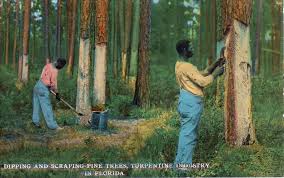 Turpentine was originally from Persia and was recovered from the turpentine tree (Pistacia terebinthus). Which grows in dry places in the Mediterranean.
Turpentine was originally from Persia and was recovered from the turpentine tree (Pistacia terebinthus). Which grows in dry places in the Mediterranean.
The resin that flows from the wounds of a coniferous tree produces after distillation volatile turpentine oil (and mixture of hydrocarbons (mainly diterpenes)) and non- volatile rosin.
Nowadays it comes from conifers (Pinaceae). The resin, gum turpentine, is with steam distilled until a colorless liquid: turpentine oil (Oleum terebinthinae). This can also be removed by distillation or rectification of the timber.
Turpentine is used in painting to oil dilution. Turpentine is an excellent solvent for linseed oil (and thickened and boiled linseed oil).
In the pharmaceutical industry is the oil use in analgesic ointments and cough medicines.
Turpentine is relative to the petroleum product Mineral turpentine or (white) spirit quite costly. Both are similar. The smell of turpentine is resinous, mineral turpentine is more like that of gasoline.
Artificial turpentine is another name for solvent naphtha or white spirit.
